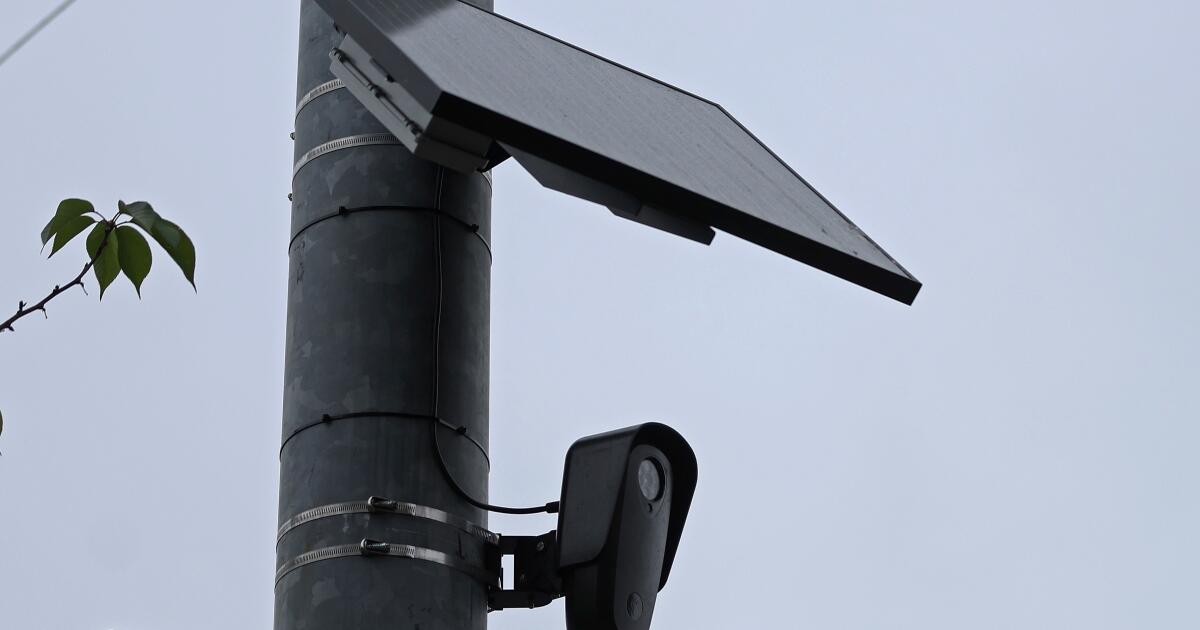Soon a large swath of the San Fernando Valley will be under the watchful eye of 100 license plate-reading cameras that Los Angeles officials hope will help police crack down on burglaries, robberies and other neighborhood crimes.
On Thursday, Councilman John Lee announced the Los Angeles Police Department and other city departments are already working toward installing the cameras by the end of the year. The cameras will be at or near intersections in Chatsworth, Northridge, Granada Hills, Sherwood Forest, Porter Ranch, West Hills and North Hills.
These communities “have been asking for change and pleading with their government representatives to address issues of crime” in their neighborhoods, Lee said in a statement.
“While I know there is always more we can do, it brings me immense hope to know that we’ve been able to deliver this project for the Northwest San Fernando Valley,” he said.
An automated license plate reader camera takes a photo or a video of a vehicle’s license plate information. With optical character recognition the plate number is compared to one or more law enforcement crime databases of vehicles of interests or “hot lists,” according to the International Assn. of Chiefs of Police.
The reader technology can also detect the vehicle type and color, GPS location data and date and time of an incident, according to the Congressional Research Service. The cameras can be fixed onto poles, traffic lights, buildings or bridges and mobile cameras are frequently mounted on police cars.
In January, Lee introduced a motion to set aside $500,000 to fund and purchase the automated cameras for the Valley and tasked the police department, the Bureau of Street Lighting and the city’s Department of Transportation to begin researching locations and methods for the installation of the cameras to best assist police.
Installation of the cameras began in September and has already resulted in two arrests, according to Lee’s office.
In one case, officers were able to identify a stolen vehicle after suspects allegedly assaulted and attempted to rob a victim who successfully captured the vehicle’s license plate, his office said. The victim shared the license plate number with police officers, who were able to use the plate number to locate the vehicle via one of its new cameras and make an arrest.
In the second instance, officers were able to use a larger network of reader cameras to locate a suspect who allegedly forcibly removed a Rolex watch from a victim’s wrist. Officers tracked the suspect’s vehicle to a motel room and arrested the suspect, according to Lee’s office.
The decision to install reader cameras in the Valley came after the LAPD’s Devonshire Division reported a 23% increase in burglaries across the entire service area in 2023 and a 103% increase in burglaries in neighborhoods north of Rinaldi Street. The department did not share the crime statistics for 2022.
Automated license plate reader camera technology is already used by the Los Angeles Police Department, however, the implementation of this technology at fixed locations in residential and business areas is the first of its kind in the city, Lee’s office said.
According to a 2020 survey by the Bureau of Justice Statistics, nearly 90% of sheriffs’ offices with 500 or more sworn deputies reported using the technology while 100% of policing departments serving more than 1 million residents used reader cameras.
Opponents of the technology, including the American Civil Liberties Union, complain that the technology and its database have few or no restrictions to protect privacy rights.
In 2020 the state auditor found that the LAPD and three other California law enforcement agencies did not provide sufficient privacy protections of hundreds of millions of images collected by automated license plate readers and shared them with other jurisdictions.
The audit found that 99.9% of the 320 million images the LAPD stored came from vehicles that were not on a list of those involved in criminal investigations when the image was made by the automated license plate readers, or ALPR.
“When it comes to license plate readers and privacy, a consumer’s best option to retain their privacy is to ride a bike,” said Gregory Nojeim, senior counsel for the Center for Democracy and Technology. “I say that because all vehicles that are required to have license plates are subject to the new surveillance system.”
Nojeim said residents in the seven neighborhoods that will have reader cameras should understand that when they travel on roads, law enforcement will have a record of where everybody was, who was the subject, and who passed the camera based on license plate information.
The collected information stored as an ALPR record is maintained “for a set period within California that ranges by jurisdiction from 60 days to 5 years,” unless it is reasonably believed it will become evidence in a criminal or civil action, the Northern California Regional Intelligence Center states.
“It’s like having your own Wayback Machine where you can look at where people were in the past,” he said.
What’s concerning is law enforcement officials don’t need a warrant to assess the data collected by the reader camera and they don’t need a judge’s approval to assess the data either, Nojeim said.
“This … surveillance [will] occur 24 hours a day at 100 locations [in the Valley] once cameras are installed and it doesn’t matter whether you’re going about your life, shopping for groceries or picking up your kids from the soccer game,” he said. “What matters is whether you’re near a camera and whether the camera can spot your license plate.”
You become a target of surveillance, he said.
